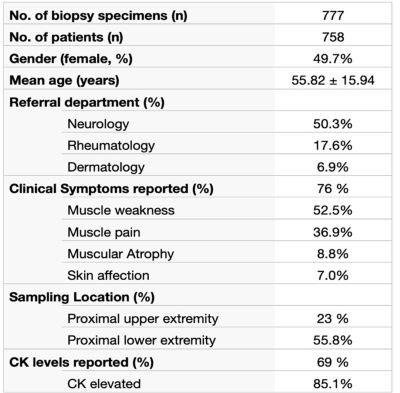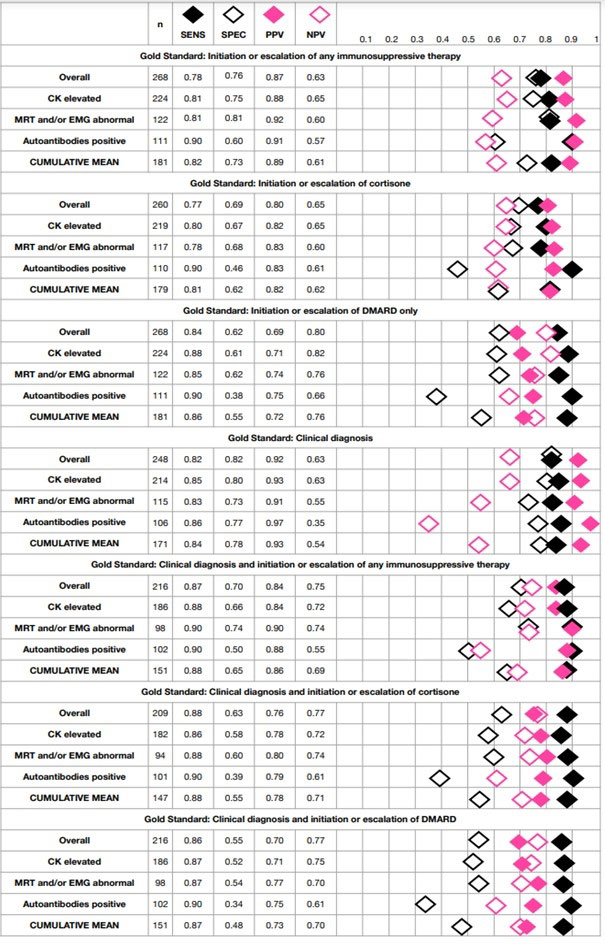Session Information
Session Type: Poster Session A
Session Time: 1:00PM-3:00PM
Background/Purpose: Diagnosis of idiopathic inflammatory myopathies (IIM) represents a clinical challenge and muscle biopsy is regarded as a fundamental procedure for confirming diagnosis. However, the significance of muscle biopsy as diagnostical technique remains inconclusive. The aim of this study was to evaluate the diagnostic accuracy, performance, and clinical relevance of muscle biopsy in patients with suspected myositis.
Methods: Results of muscle biopsies of adult patients with clinically suspected or differential diagnosis of myositis referred from all over Austria to the Medical University of Vienna between 2007-2021 were analyzed. Information was extracted from handwritten assignment sheets, including suspected diagnosis (inflammatory and/or non-inflammatory myopathy), referral department, sampling location, demographic, clinical, laboratory and serologic data, and imaging results. Histological findings were grouped in: 1) inflammatory, 2) non-inflammatory (neurogenic, metabolic etc.), 3) inflammatory and non-inflammatory mixed, and 4) normal.
Clinical information including symptoms, laboratory results, medication, and imaging were retrieved form electronical medical records (EMR). Sensitivity, specificity, positive (PPV) and negative predictive values (NPV) of final histological results were calculated using diagnosis by the clinician and initiation/escalation of immunosuppressive therapy as gold standards.
Results: Out of 758 patients with muscle biopsy, 527 (69.5%) were referred with the suspected diagnosis of myositis only and 231 (30.5%) were referred with the differential diagnosis of myositis. Out of 527 samples with suspected diagnosis of myositis only, diagnosis was confirmed histologically in 249 (47.3%) cases; 39/527 (7.4%) specimen additionally showed co-features of non-inflammatory myopathy, whereas 221 (41.9%) were non-inflammatory at all. Out of 231 samples with differential diagnosis of non-inflammatory myopathies in addition to myositis, 52 (22.5%) were histologically inflammatory only and 17 (7.4%) showed mixed features. 151 (65.4%) biopsies were exclusively non-inflammatory.
Probability of histopathological diagnosis of inflammatory myopathy declined significantly, when CK levels were normal or myositis was stated as differential diagnosis. High clinical probability of myositis (muscular symptoms, elevated CK and MRI and/or EMG suggestive for myopathy) was indicative for myositis in biopsy (64.3%). Overall sensitivity and specificity of muscle biopsy were 82% when diagnosis by the clinician was set as gold standard. When initiation of immunosuppression is considered gold standard, a decline of sensitivity and specificity was observed. Pathological results suggestive for myositis (elevated CK levels, positive autoantibodies and pathologic EMG/MRI) led to decrease of specificity and negative predictive value (figure 1).
Conclusion: If myositis was suspected only or as differential diagnosis, approximately 47% of the biopsies revealed an inflammatory myopathy. Sensitivity and specificity of biopsy was moderate to high when using start of immunosuppression or diagnosis by the clinician as gold standard for IIM diagnosis.
To cite this abstract in AMA style:
Kastrati K, NAKHOST LOTFI N, Tawfik M, Gelpi E, Hoeftberger R, Kiener H, Aletaha D, Bonelli M, Radner H. Diagnostic Accuracy and Clinical Relevance of Muscle Biopsy in Patients with Suspected Myositis [abstract]. Arthritis Rheumatol. 2022; 74 (suppl 9). https://acrabstracts.org/abstract/diagnostic-accuracy-and-clinical-relevance-of-muscle-biopsy-in-patients-with-suspected-myositis/. Accessed .« Back to ACR Convergence 2022
ACR Meeting Abstracts - https://acrabstracts.org/abstract/diagnostic-accuracy-and-clinical-relevance-of-muscle-biopsy-in-patients-with-suspected-myositis/


